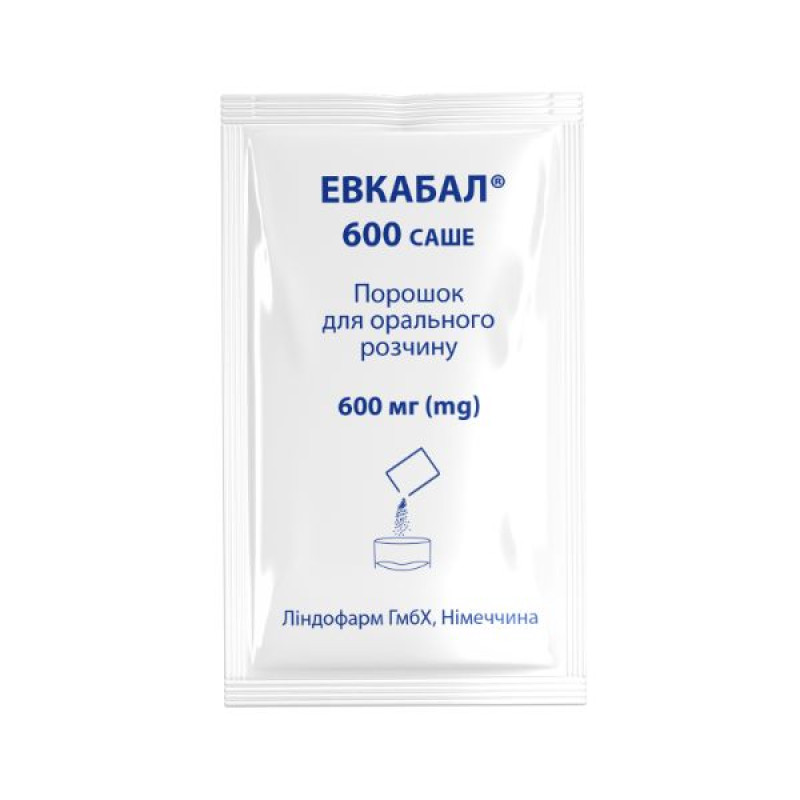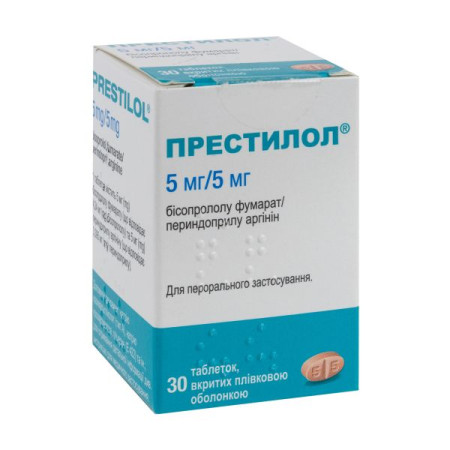Eucabal 600 sachets powder for oral solution 600 mg sachet 3 g No. 20

Instructions for Evkabal 600 sachets powder for oral solution 600 mg sachet 3 g No. 20
Composition
active ingredient: acetylcysteine;
1 sachet contains 600 mg of acetylcysteine;
excipients: sucrose, orange flavoring, colloidal anhydrous silicon dioxide, tartaric acid, sodium chloride.
Dosage form
Powder for oral solution.
Main physicochemical properties: white or almost white homogeneous powder with a fruity odor, free from agglomerates and foreign particles.
Pharmacotherapeutic group
Mucolytic agents.
ATX code R05C B01.
Pharmacological properties
Pharmacodynamics.
Acetylcysteine is a derivative of the amino acid cysteine. Acetylcysteine has secretolytic and secretomotor effects in the bronchial tract. It is believed that it breaks disulfide bonds of mucopolysaccharides and has a depolymerizing effect on DNA (in purulent mucus). This mechanism contributes to a decrease in mucus viscosity. An alternative mechanism of acetylcysteine is probably based on the ability of its chemically active sulfhydryl group to bind and thus neutralize chemical radicals.
Acetylcysteine helps increase the synthesis of glutathione, which is important for the detoxification of harmful factors. This explains the effect of acetylcysteine as an antidote for paracetamol poisoning.
Prophylactic administration of acetylcysteine reduced the frequency and severity of bacterial exacerbations in patients with chronic bronchitis/cystic fibrosis.
Pharmacokinetics.
After oral administration, acetylcysteine is rapidly and completely absorbed. It is metabolized in the liver to form the pharmacologically active metabolite cysteine, as well as diacetylcysteine, cystine and further mixed disulfides. Due to the significant first-pass effect, the bioavailability of acetylcysteine when administered orally is very low (about 10%). The maximum plasma concentration is reached 1-3 hours after administration, with the maximum plasma concentration of the cysteine metabolite being approximately 2 μmol/l. Plasma protein binding is approximately 50%.
Acetylcysteine and its metabolites occur in the body in three different forms: partly in free form, partly in a form bound to proteins through labile disulfide bridges, and partly in the form of incorporated amino acids. Acetylcysteine is excreted by the kidneys in the form of inactive metabolites (inorganic sulfates, diacetylcysteine). The half-life is determined mainly by rapid biotransformation in the liver and is approximately 1 hour. In case of decreased liver function, the half-life is extended to 8 hours.
Distribution
Acetylcysteine is distributed in the body both in unchanged form (20%) and in the form of active metabolites (80%). It is mainly found in the lungs, bronchial secretions, liver and kidneys. The volume of distribution of acetylcysteine is from 0.33 to 0.47 l/kg. Binding to plasma proteins is about 50% 4 hours after administration and decreases to 20% after 12 hours.
Metabolism and excretion
After oral administration, acetylcysteine is rapidly and extensively metabolized in the intestinal wall and liver. About 30% of the dose is excreted by the kidneys. T1/2 of acetylcysteine is 6.25 hours.
N-acetylcysteine crosses the placental barrier and is found in cord blood. There is no information on the penetration into breast milk. There is no information on the penetration of acetylcysteine through the blood-brain barrier.
Indication
It is used to reduce the viscosity of sputum, improve its discharge and expectoration in bronchitis caused by colds.
Contraindication
Known hypersensitivity to acetylcysteine or any of the excipients. Gastric and duodenal ulcer in the acute stage, hemoptysis, pulmonary hemorrhage.
Children under 14 years old.
Interaction with other medicinal products and other types of interactions
Interaction studies were conducted only in adults.
The use of antitussives together with acetylcysteine may increase sputum congestion due to suppression of the cough reflex, therefore indications for such combined treatment should be established with particular caution.
Information on the inactivation of antibiotics (tetracycline, aminoglycosides, penicillins) by acetylcysteine has been associated exclusively with in vitro studies in which the relevant substances were mixed directly. However, for safety reasons, the interval between the use of these drugs should be at least 2 hours. This does not apply to cefixime and loracarbef.
Concomitant use of acetylcysteine and glyceryl trinitrate (nitroglycerin) may potentiate the vasodilatory and antiplatelet effects of nitroglycerin. If concomitant use of nitroglycerin and acetylcysteine is necessary, patients should be monitored for hypotension, which may be severe. Patients should be warned of the possibility of headache.
Activated charcoal reduces the effectiveness of acetylcysteine.
It is not recommended to dissolve acetylcysteine with other drugs in the same glass.
Effect on laboratory tests: Acetylcysteine may interfere with the results of colorimetric tests for salicylates and the determination of ketone bodies in urine.
Application features
It is recommended to use the drug with caution in patients with a history of gastric and duodenal ulcers, especially in case of concomitant use of other medications that irritate the gastric mucosa.
Severe skin reactions (Stevens-Johnson and Lyell syndromes) have been reported with acetylcysteine, so if changes occur on the skin or mucous membranes, the drug should be discontinued immediately and a doctor should be consulted regarding its continued use.
Acetylcysteine should be prescribed with caution to patients with bronchial asthma due to the possible development of bronchospasm. If the contents of the sachet are poured into dishes during the preparation of the solution, the powder may enter the air and irritate the nasal mucosa, which may result in reflex bronchospasm. In the event of bronchospasm, treatment with the drug should be stopped immediately and consult a doctor.
Acetylcysteine should be prescribed with caution to patients with liver or kidney diseases to avoid the accumulation of nitrogen-containing substances in the body.
The use of acetylcysteine, especially at the beginning of treatment, causes liquefaction of bronchial secretions and, thus, an increase in their volume. If the patient is unable to cough up sputum effectively, postural drainage and bronchoaspiration are necessary.
Acetylcysteine affects histamine metabolism, so long-term therapy should not be prescribed to patients with histamine intolerance, as this may lead to symptoms of intolerance (headache, vasomotor rhinitis, itching).
Mucolytics can cause bronchial obstruction in children under 2 years of age. Due to the physiological characteristics of the respiratory system in children of this age group, the ability to clear respiratory secretions is limited. Therefore, mucolytics should not be used in children under 2 years of age.
A slight sulfuric odor is not a sign of a change in the drug, it is specific to the active ingredient.
One sachet of "EUCABAL®600 sachets" contains less than 1 mmol (23 mg) of sodium, i.e. practically free of sodium.
The drug contains sucrose, so it should not be prescribed to patients with rare hereditary forms of fructose intolerance, sucrase-isomaltase deficiency or glucose-galactose malabsorption syndrome.
One sachet of "EUCABAL®600 sachets" contains 2.3 g of sucrose (approximately 0.2 bread units). This should be taken into account when using the drug in patients with diabetes.
The preparation contains orange flavoring, which contains lactose. Patients with rare hereditary problems of galactose intolerance, the Lapp lactase deficiency or glucose-galactose malabsorption should not take "EUCABAL®600 Sachets".
Use during pregnancy or breastfeeding
Pregnancy
There are no adequate clinical data on the effects of acetylcysteine on pregnant women. Experimental studies in animals have not revealed direct or indirect negative effects on the course of pregnancy, embryo-fetal development, childbirth and postnatal development. Before using the drug during pregnancy, the potential risks should be compared with the expected benefits.
Breast-feeding
There is no information on the passage of acetylcysteine into breast milk. The drug should be used during pregnancy or breastfeeding only after a careful assessment of the benefit/risk ratio.
Fertility
Animal studies have not shown any harmful effects on human fertility when using the drug at recommended doses.
Ability to influence reaction speed when driving vehicles or other mechanisms
There is no evidence that acetylcysteine affects the ability to drive and use machines.
Method of administration and doses
It is recommended to take the drug after meals dissolved in a glass of water.
Unless otherwise prescribed, adults and adolescents aged 14 years and over should take 1 sachet of powder per day (equivalent to 600 mg of acetylcysteine per day).
The drug should not be used for more than 4-5 days without consulting a doctor.
Children
Use in children under 14 years of age is contraindicated.
Overdose
There are no reports of overdose with oral acetylcysteine formulations. Volunteers have taken 11.2 g of acetylcysteine per day for three months without any serious adverse effects. Oral acetylcysteine at doses of 500 mg/kg/day has been tolerated without signs of intoxication.
Symptoms.
Overdose may cause gastrointestinal symptoms such as nausea, vomiting and diarrhea. Children are at risk of hypersecretion.
Treatment.
Therapy is symptomatic.
Side effects
Adverse reactions are classified by frequency as follows: very common (≥ 1/10), common (≥ 1/100 to < 1/10), uncommon (≥ 1/1000 to < 1/100), rare (≥ 1/10,000 to < 1/1000), very rare (< 1/10,000), not known (frequency cannot be estimated from the available data).
| Organ system | Adverse reactions | |||
| Infrequently | Rarely | Very rare | Unknown | |
| On the part of the immune system | Anaphylactic shock, anaphylactic/anaphylactoid reactions | |||
| Blood and lymphatic system disorders | Anemia | |||
| From the nervous system | Headache | |||
| From the side of the organs of hearing and labyrinth | Tingle | |||
| Respiratory system | Rhinorrhea | |||
| Cardiovascular system | Tachycardia | Hemorrhages | ||
| From the side of the chest and mediastinum | Bronchospasm - mainly in patients with bronchial hyperreactivity in bronchial asthma, dyspnea | |||
| Gastrointestinal tract | Vomiting, diarrhea, stomatitis, abdominal pain, nausea | Dyspepsia | Bad breath | |
| Skin and subcutaneous tissue disorders | Urticaria, rash, exanthema, angioedema, pruritus | Eczema | ||
| General disorders and administration site conditions | Hyperthermia | Facial swelling | ||
| Research | Lowering blood pressure | |||
In addition, very rare cases of bleeding have been reported with the use of acetylcysteine, sometimes due to hypersensitivity reactions.
In very rare cases, severe skin reactions, such as Stevens-Johnson syndrome and Lyell's syndrome, have been reported in association with acetylcysteine. In most cases, at least one other drug may have been the cause of the mucocutaneous syndrome.
If any new changes appear on the skin or mucous membranes, you should consult a doctor and immediately stop taking acetylcysteine.
Cases of decreased platelet aggregation have been reported, but the clinical significance of this has not been determined.
Reporting of suspected adverse reactions.
Reporting suspected adverse reactions after a medicinal product has been authorised is important. This allows for continuous monitoring of the benefit-risk balance of the medicinal product. Physicians should report any suspected adverse reactions as required by law.
Expiration date
3 years.
Storage conditions
Store in the original packaging at a temperature not exceeding 30 °C.
Keep out of reach of children.
Packaging
3 g of powder (600 mg of active ingredient) in a sachet. 10, 20, or 50 sachets in a cardboard box.
Vacation category
Without a prescription.
Producer
Lindopharm GmbH.
Location of the manufacturer and address of its place of business
Neustrasse 82, 40721 Gilden, Germany.
Applicant
Esparma GmbH.
Location of the applicant.
Bielefelder Strasse 1, 39171 Sulzetal, Germany.
There are no reviews for this product.
There are no reviews for this product, be the first to leave your review.
No questions about this product, be the first and ask your question.















